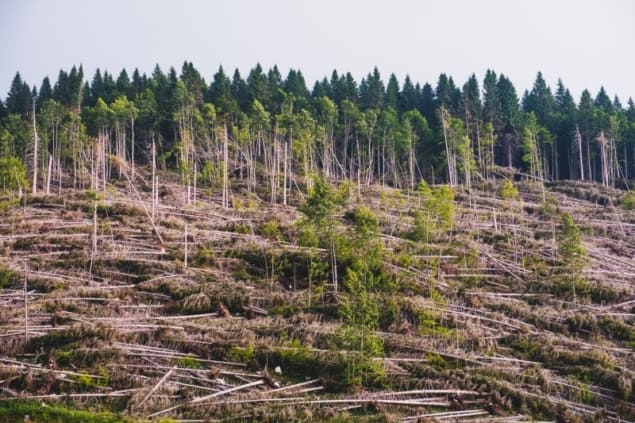
Forests play a key role in the effort to contain climate change driven by human combustion of fossil fuels. But as the Arctic burns and fires race through the Amazon forest four new studies cast doubt on whether the planetary canopy can keep up.
The boreal forests of the north-west territories of Canada are home to vast tracts of spruce and other conifers: they cover soils so rich in carbon that a square metre could hold 75 kilograms of life’s most vital element.
But in 2014 wildfires made more probable by rising temperatures spread across more than 2.8 million hectares of Canada, turning at least 340,000 ha of the territories from a carbon sink into a source for more planet-heating greenhouse gas.
Limit to benefits
More carbon dioxide should fertilise more abundant growth in those forests not destroyed by fire and drought. But a new study from California and Spain warns that by 2100, the woodland world may reach breaking point. It isn’t clear that forests can go on benefiting from higher levels of carbon dioxide.
And new measurements from the Amazon, which in theory absorbs around a quarter of all human fossil fuel emissions each year, demonstrate why: the region’s soils are deficient in phosphorus. Without this vital element, the trees cannot take full advantage of the extra carbon fertilizer.
A fourth study presents an overall picture of change driven in some way by climate change. Fires, windstorms, insect outbreaks and other large disturbances account for more than a tenth of all tree death worldwide.
That the world’s forests are part of the campaign to mitigate climate change is not in doubt: one study even presents a picture of all waste land covered by new canopy as possibly the solution. There are an estimated three trillion trees on the planet, being destroyed at the rate of 15 billion a year. Losses are happening worldwide but nowhere with more devastating consequences than in the rainy tropics.
But fire and drought are now more frequent even in the temperate and northern zones. Researchers from the US and Canada visited 200 different stands of scorched and incinerated spruce forest to sample the levels of carbon in the soils. They report in the journal Nature that as fires become more frequent, ever more of the rich legacy of carbon stored over hundreds of thousands of years of green canopy is being returned to the atmosphere.
“In older stands that burn, this carbon is protected by thick organic soils,” said Xanthe Walker, graduate of the University of Saskatchewan and now at Northern Arizona University. “But in younger stands that burn, the soil does not have time to re-accumulate. after the previous fire, making legacy carbon vulnerable to burning. This pattern could shift boreal forests to a new domain of carbon cycling, where they become a carbon source instead of a sink.”
Researchers wonder in the journal Nature Climate Change about the capacity of forests to go on indefinitely absorbing ever more carbon dioxide, given that to do so they will also need ever more nitrogen and phosphorus.
Losses already happening
Scientists from Stanford University in California and the Autonomous University of Barcelona took data from 138 experiments with heightened atmospheric carbon dioxide over cropland, grasslands, shrubs and forests and used computer models to peer into the future.
By the end of the century, this extra greenhouse gas could boost the biomass of foliage by 12% − the equivalent of about six years of fossil fuel emissions. But the forests of the Amazon, the Congo and Indonesia will be crucial.
“We have already witnessed indiscriminate logging in pristine tropical forests, which are the largest reservoirs of biomass on the planet,” said César Terrer of Stanford University. “We stand to lose a tremendously important tool to limit global warming.”
Now a study from an international team suggests that some forest capacity is already being lost. They report in Nature Geoscience that they used computer models to check the increasing uptake of carbon in the Amazon, given the finite levels of soil phosphorus, a condition current estimates have not properly taken into account. The news is not encouraging.
Multiple stresses
“In reality the ecosystem is millions of years old, highly weathered and therefore depleted on phosphorus in many parts of the Amazon,” said Jennifer Holm of Lawrence Berkeley National Laboratory, one of the authors.
And even if there was a healthy supply of nutrients, the stresses linked to rising temperatures – greater extremes of flood, heat, drought and wind – will take their toll. Scientists from Europe and the US studied the satellite data to build up a picture of profit and loss in the wooded world and found that, along with harvesting, such upsets account for 12% of forest loss. And with the loss, the surrender of carbon continues, they suggest in the journal Nature Geoscience.
“This year’s large fires across the Arctic may be just an anomaly, they may be a sign that disturbances in the region are becoming more frequent relative to the historical norm,” said Thomas Pugh of the University of Birmingham in the UK, who led the research.
“If that’s the case, we can expect large amounts of carbon to be released from these forests over the coming century and perhaps wholesale changes in the mix of vegetation that make up the forests.”
- This article first appeared at Climate News Network



